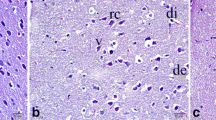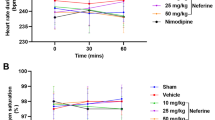Abstract
Stroke is still a major cause of death and permanent neurological disability. As humic acids are well-known antioxidant molecules, the purpose of this study was to investigate the potential neuroprotective effects of humic acid in a focal cerebral ischemia model. Twenty-four rats were divided equally into three groups. A middle cerebral artery occlusion model was performed in this study where control (group II) and humic acid (group III) were administered intraperitoneally following an ischemic experimental procedure. Group I was evaluated as sham. Malondialdehyde (MDA), superoxide dismutase (SOD), and nuclear respiratory factor-1 (NRF-1) levels were analyzed biochemically on the right side of the ischemic cerebral hemisphere, while ischemic histopathological studies were completed on the left side to investigate the antioxidant status. Biochemical results showed that SOD and NRF-1 levels were significantly increased in the humic acid group (III) compared with the control group (II) while MDA levels were significantly decreased. On histopathological examination, cerebral edema, vacuolization, degeneration, and destruction of neural elements were decreased in the humic acid group (III) compared with the control group (II). Cerebral ischemia was attenuated by humic acid administration. These observations indicate that humic acid may have potential as a therapeutic agent in cerebral ischemia by preventing oxidative stress.




Similar content being viewed by others
References
Brouns, R., and P.P. De Deyn. 2009. The complexity of neurological processes in acute ischemic stroke. Clinical Neurology and Neurosurgery 111: 483–495.
Lipton, P. 1999. Ischemic cell death in brain neurons. Physiological Reviews 79: 1431–1568.
Kuroda, S., and B.K. Siesjo. 1997. Reperfusion damage following focal ischemia: pathophysiology and therapeutic windows. Clinical Neuroscience 4: 199–212.
Chan, P.H. 2001. Reactive oxygen radicals in signaling and damage in the ischemic brain. Journal of Cerebral Blood Flow and Metabolism 21: 2–14.
Zimmermann, C., K. Winnefeld, S. Streck, M. Roskos, R.L. Haberl, et al. 2004. Antioxidant status in acute stroke patients and patients at stroke risk. European Neurology 51: 157–61.
Simonyi, A., Q. Wang, R.L. Miller, et al. 2005. Polyphenols in cerebral ischemia: novel targets for neuroprotection. Molecular Neurobiology 31(1–3): 135–47.
Gilgun-Sherki, Y., E. Melamed, and D. Offen. 2001. Oxidative stress induced-neurodegenerative diseases: the need for antioxidants that penetrate the blood brain barrier. Neuropharmacology 40: 959–975.
Cho, J.Y., I.S. Kim, Y.H. Jang, et al. 2006. Protective effect of quercetin, a natural flavonoid against neuronal damage after transient global cerebral ischemia. Neuroscience Letters 404: 330–335.
Hartenstein, R. 1981. Sludge decomposition and stabilization. Science 212(802): 743–749.
Chen, Y., J. Katan, A. Gamliel, et al. 2000. Involvement of soluble organic matter in increased plant growth in solarized soils. Biology and Fertility of Soils 32: 28–34.
-Gostishcheva M.V.2008. Chemical-pharmaceutical study of native humic acids from peats of Tomsk Oblast, Cand. Sci. Dissertation, Perm
Van Rensburg, C.E.J., A. Van Straten, and J. Dekker. 2000. An in vitro investigation of the antimicrobial activity of oxifulvic acid. Journal of Antimicrobial Chemotherapy 46: 853–854.
Van Rensburg, C.E.J., S.C.K. Malfield, and J. Dekker. 2001. Topical application of oxifulvic acid suppresses the cutaneous immune response in mice. Drug Development Research 53: 29–32.
Cloete T. E, Swart H, Cronje I. J et al.1990. Oxidized coal products as industrial bactericides. Third International Symposium on Gas, Oil, Coal and Environmental Biotechnology, New Orleans, Louisiana, 3–5 December.
Van Rensburg, C.E.J., J. Dekker, R. Weis, et al. 2002. Investigation on the anti-HIV properties of oxihumate. Chemotherapy 48: 138–143.
Thiel, K.D., B. Helbig, R. Klöcking, et al. 1981. Comparison of the in vitro activities of ammonium humate and of enzymically oxidized chlorogenic and caffeic acids against type 1 and type 2 human herpes virus (author’s transl). Pharmazie 36(1): 50–3. German.
Vucskits, A.V., I. Hullár, A. Bersényi, et al. 2010. Effect of fulvic and humic acids on performance, immune response and thyroid function in rats. Journal of Animal Physiology and Animal Nutrition (Berlin) 94(6): 721–8.
Efimova, I.V., S.L. Khil’ko, and O.V. Smirnova. 2012. Antioxidant activity of humic acids in radical-chain oxidation processes. Russian Journal of Applied Chemistry 85(9): 1351–54.
Longa, E.Z., P.R. Weinstein, S. Carlson, et al. 1989. Reversible middle cerebral artery occlusion without craniectomy in rats. Stroke 20(1): 84–91.
Lowry, O.H., N.J. Rosebrough, A.L. Farr, et al. 1951. Protein measurement with the Folin phenol reagent. Journal of Biological Chemistry 193: 265–75.
Sun, Y., L.W. Oberley, and Y. Li. 1988. A simple method for clinical assay of superoxide dismutase. Clinical Chemistry 34: 497–500.
Durak, I., Z. Yurtarslanl, O. Canbolat, et al. 1993. A methodological approach to superoxide dismutase (SOD) activity assay based on inhibition of nitroblue tetrazolium (NBT) reduction. Clinica Chimica Acta 214: 103–4.
Buege, J.A., and S.D. Aust. 1978. Microsomal lipid peroxidation. Methods in Enzymology 52: 302–10.
Park, H.S., K.H. Han, J.A. Shin, et al. 2014. The neuroprotective effects of carnosine in early stage of focal ischemia rodent model. Journal of Korean Neurosurgical Society 55(3): 125–30.
Bonita, R., S. Mendis, T. Truelsen, et al. 2004. The global stroke initiative. Lancet Neurology 3: 391–393.
Evans, P.H. 1993. Free radicals in brain metabolism and pathology. British Medical Bulletin 49: 577–587.
Durukan, A., and T. Tatlisumak. 2007. Acute ischemic stroke: overview of major experimental rodent models, pathophysiology, and therapy of focal cerebral ischemia. Pharmacology Biochemistry and Behavior 87: 179–197.
Braughler, J.M., and E.D. Hall. 1989. Central nervous system trauma and stroke. I. Biochemical considerations for oxygen radical formation and lipid peroxidation. Free Radical Biology and Medicine 6: 289–301.
Bromont, C., C. Marie, and J. Bralet. 1989. Increased lipid peroxidation in vulnerable brain regions after transient forebrain ischemia in rats. Stroke 20(7): 918–24.
Zhang, Q., Y. Wu, P. Zhang, et al. 2012. Exercise induces mitochondrial biogenesis after brain ischemia in rats. Neuroscience 15(205): 10–7.
St-Pierre, J., S. Drori, M. Uldry, et al. 2006. Suppression of reactive oxygen species and neurodegeneration by the PGC-1 transcriptional coactivators. Cell 127(2): 397–408.
EMEA. Humic acids and their sodium salts, summary report. Committee for Veterinary Medicinal Products. European Agency for the Evaluation of Medicinal Products Available via http://www.ema.europa.eu/docs/en_GB/document_library/Maximum_Residue_Limits_-Report/2009/11/WC500014416.pdf; 1999
Brzozowski, T., A. Dembiński, and S. Konturek. 1994. Influence of Tołpa Peat Preparation on gastroprotection and on gastric and duodenal ulcers. Acta Poloniae Pharmaceutica 51(1): 103–7.
Riede, U.N., I. Jonas, B. Kirn, et al. 1992. Collagen stabilization induced by natural humic substances. Archives of Orthopaedic and Trauma Surgery 111(5): 259–64.
Hu, C.W., C.C. Yen, Y.L. Huang, et al. 2010. Oxidatively damaged DNA induced by humic acid and arsenic in maternal and neonatal mice. Chemosphere 79(1): 93–9.
Hseu, Y.C., S.C. Chen, Y.L. Chen, et al. 2008. Humic acid induced genotoxicity in human peripheral blood lymphocytes using comet and sister chromatid exchange assay. Journal of Hazardous Materials 153: 784–791.
Gau, R.J., H.L. Yang, J.L. Suen, et al. 2001. Induction of oxidative stress by humic acid through increasing intracellular iron: a possible mechanism leading to atherothrombotic vascular disorder in blackfoot disease. Biochemical and Biophysical Research Communications 283: 743–749.
Cheng, M.L., H.Y. Ho, Y.W. Huang, et al. 2003. Humic acid induces oxidative DNA damage, growth retardation, and apoptosis in human primary fibroblasts. Experimental Biology and Medicine (Maywood, N.J.) 228(4): 413–23.
Cheng, M.L., H.Y. Ho, D.T. Chiu, et al. 1999. Humic acid-mediated oxidative damages to human erythrocytes: a possible mechanism leading to anemia in blackfoot disease. Free Radical Biology and Medicine 27(3–4): 470–477.
Kodama, H., and Denso. 2007. Antitumor effect of humus extract on murine transplantable L1210 leukemia. Journal of Veterinary Sciences and Medicine 69: 1069–1071.
Kodama, H., Okazaki F. Denso, and S. Ishida. 2008. Protective effect of humus extract against Trypanosoma brucei infection in mice. Journal of Veterinary Medical Science 70(11): 1185–90.
Joone, G.K., J. Dekker, and C.E. Van Rensburg. 2003. Investigation of the immunostimulatory properties of oxihumate. Zeitschrift fu¨ r Naturforschung. C 58: 263–267.
Conflict of Interest
The authors declare no conflicts of interest.
Financial Support
No financial support
Author information
Authors and Affiliations
Corresponding author
Rights and permissions
About this article
Cite this article
Ozkan, A., Sen, H.M., Sehitoglu, I. et al. Neuroprotective Effect of Humic Acid on Focal Cerebral Ischemia Injury: an Experimental Study in Rats. Inflammation 38, 32–39 (2015). https://doi.org/10.1007/s10753-014-0005-0
Published:
Issue Date:
DOI: https://doi.org/10.1007/s10753-014-0005-0




